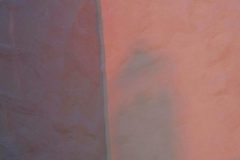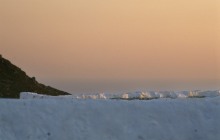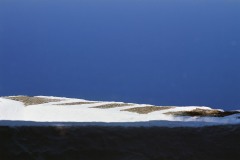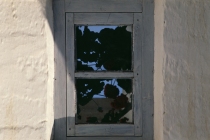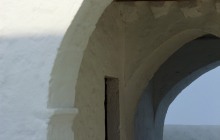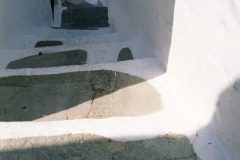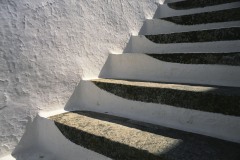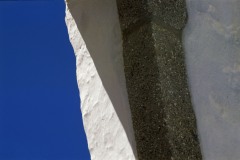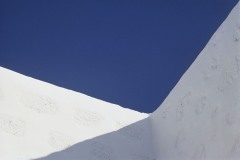“ Je me trouvais dans l’île de Patmos” écrit St. Jean dans l’Apocalypse. Je me trouvais moi aussi il y a plus de quarante ans, dans l’ île de Patmos. Je voulais connaître le lieu des visions johanniques mais j’ignorais alors que je referais ce voyage chaque été et que Patmos deviendrait la source d’une expérience spirituelle. Il ne s’agissait pas bien sûr pour moi de visions, de voix, d’extases mais je découvrais une île dont la beauté, le silence, la lumière,l’âpreté des paysages me subjuguaient et c’était le commencement d’une longue aventure intérieure,faite de silence et de contemplation. Je regardais, je me promenais dans la ville haute.J’ai arpenté ainsi des étés durant, avec mon objectif, les ruelles de Chora, ces ruelles qui enserrent la forteresse du Monastère St. Jean: ruelles,murs, marches, ces éléments insignifiants à première vue, devenaient l’instant d’un regard , grâce au miracle de la lumière ,le lieu d’une ouverture, d’une brèche sur l’invisible. Je photographiais l’aube et le couchant, je traquais l’ombre et la lumière, j’interrogeais la blancheur immaculée des murs peints à la chaux , je restais en suspens devant l’azur, le bleu intense de la mer et du ciel , je respirais l’air embaumé d’encens.
J’étais certes à cent lieues des visions apocalyptiques de l’apôtre en exil mais je pressentais le mystère d’une autre lumière, cette lueur que j’entrevis un jour dans le regard d’une femme: Marika vivait dans un hameau non loin de la mer, le hameau de Christos. L’homme est toujours absent de ces images, c’est vrai, personne ne paraît au détour des ruelles, dans le silence des pierres, mais au long de ces années, j’ai vécu dans une proximité heureuse avec les insulaires : des noms me reviennent en mémoire : Vassili remontant, de Kippo, le soir avec son âne chargé de tomates, Antonio, le cordonnier, tannant ses peaux de chèvres, au bord de la mer,pour en faire des sandales, Dimitri, le secrétaire du monastère et Grégora que je guettais , à son retour de la campagne, sans oublier tous ceux et celles que je ne puis nommer. Je me souviens aussi de ces moments heureux auprès des paysans qui possédaient quelques arpents de terre cultivée , en bordure du rivage. Les mots échangés se réduisaient à peu de chose, quelques paroles en grec qui disaient la paix, la tranquillité, l’hésychia, ce terme si cher aux moines de l’Orient Chrétien.
Patmos,c’était encore les liturgies, l’Hymne des Chérubins chanté par les moines et moniales, ces mélopées du fond des âges, les Saintes Icônes contemplées sur les murs du sanctuaire, la beauté incantatoire de la Divine Liturgie.
Un 8 septembre, me promenant dans Chora et montant au monastère St. Jean, j’étais entrée dans une petite chapelle, l’icône de la Thétokos, la Mère de Dieu, veillait. Tout était silence… Au dehors, le ciel brillait d’un bleu sans tâche, les coqs lançaient leur cri, la terre exhalait ses parfums, quelque part on brûlait de l’encens, la mer impassible laissait entrevoir au loin une frêle embarcation.
La terre de Patmos m’a formée, m’a ouvert les yeux. En photographiant chaque fois les mêmes ruelles ,les mêmes escaliers dans ce périmètre autour du grand monastère, j’ai cherché l’épure , j’ai renoncé à l’accessoire et ainsi au fil des années, j’ai désiré plus de simplicité, plus d’abstraction,moins de matière.
“I was on the Island of Patmos”, writes John in the Book of Revelations. Forty years ago, I also found myself on the Island of Patmos. I went to discover the place of John’s visions, but I didn’t know that I would repeat this trip every summer and that Patmos would become the source of a spiritual journey. Of course, this didn’t mean for me visions, voices or extasy; but I discovered and island where the beauty, the light, the silence and the harshness of the landscape captivated me and it was the start of a long interior journey, made of silence and contemplation. I looked, I walked in the upper town. Thus, I wandered summers long with my objective up and down the roads of Chora, which encircle the fortress of the Monastery of Saint John: alleys, walls, steps: all elements, at first sight insignificant, but which would become the space of a glance, thanks to the miracle of light, an opening, a breach on the invisible. I photographed the dawn and the sunset, I questioned the whiteness of the chalk covered walls, I stayed suspended before the azure, the intense blue of the sea and of the sky and I breathed in the air fragrant with incense.
I was certainly very far from the apocalyptic visions of the Apostle in exile, but I sensed the mystery of a different light, the glow that one day I glimpsed in the look of a woman: Marika lived in a village not far from the sea, the village of Christos. It is true that the person is always absent from these photographs, there is no one at the turn of the road, in the silence of the stones. But over the years I lived in happy proximity with the islanders. I remember some of their names: Vassili coming back up from Kippo in the evening with his tomato-laden donkey; Antonio, the cobbler, tanning his goat skins by the sea, before turning them sandals; Dimitri the secretary of the Monastery and Grigora whom I would watch for on her return from the countryside. I remember also the happy moments with the small farmers who had a few acres of cultivated land, by the sea. The words we exchanged were few, some words in Greek, which spoke of peace, tranquility, hesychia, this term so dear to the Monks of the Christian East. Patmos meant also the liturgies, the Hymn of the Cherubim sung by the monks and the nuns, the chant of ages past, the Holy Icons contemplated on the walls of the sanctuary, the enchanting beauty of the Divine Liturgy.
One day, it was a September 8th, walking in Chora on my way up to the Monastery of Saint John, I walked into a small chapel; the icon of the Theotokos, the Mother of God, was keeping watch. All was silence … Outside, the sky was bright of a spotless blue, the cocks were crowing, the earth exhaled its perfumes, somewhere someone was burning incense, far away in the calm sea was a frail skiff.
Patmos formed me, opened my eyes. By photographing over and over again the same alleys, the same stairs, the same perimeter around the great Monastery, I sought after the essential, I abandoned the accessory and thus, over the years, I desired more simplicity, more abstraction, less matter.
